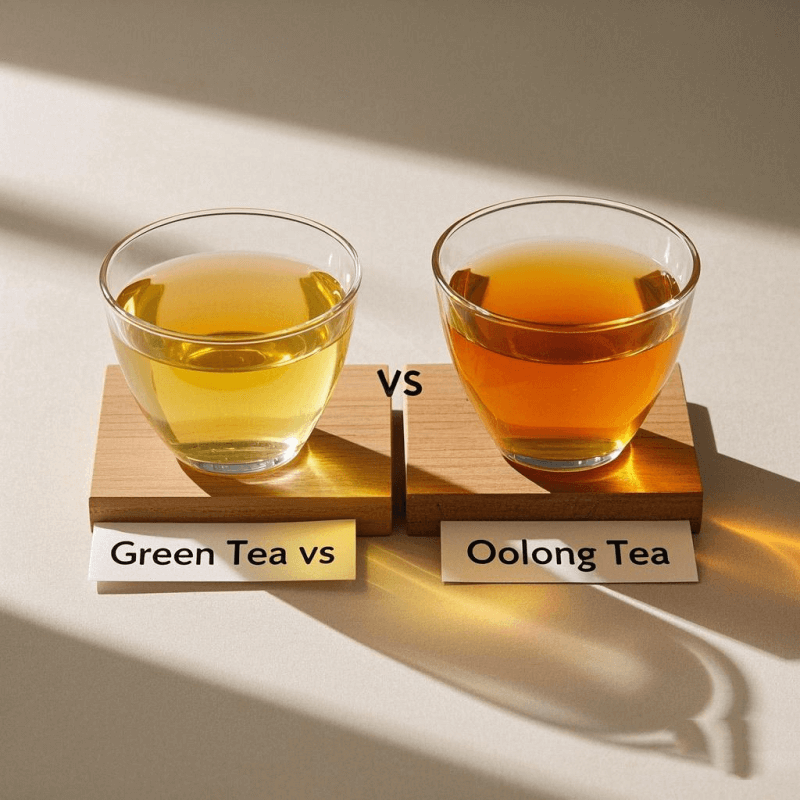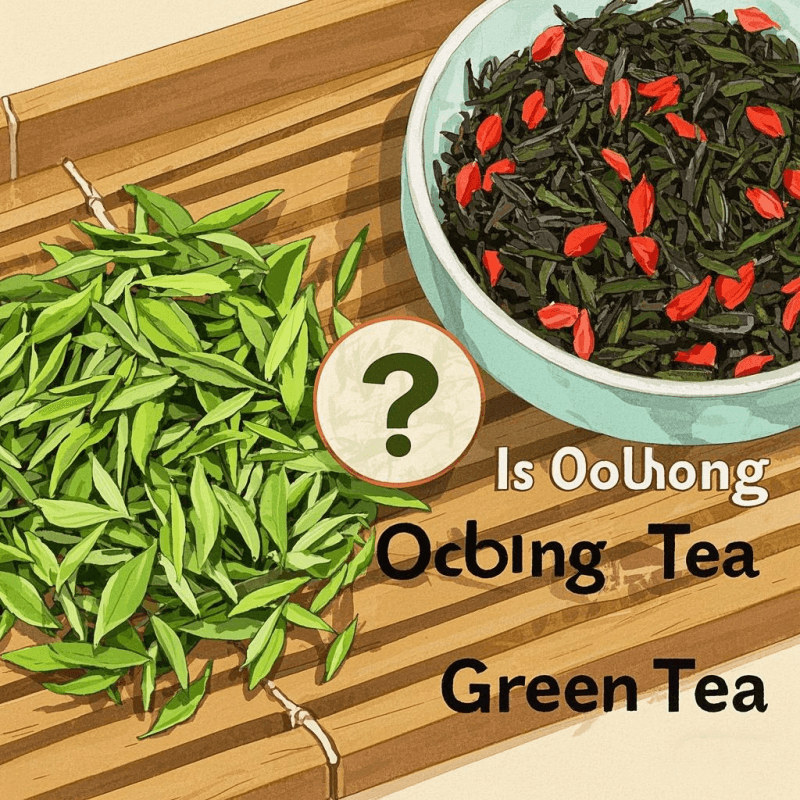
1. Introduction: Why So Many Ask “Is Oolong Tea Green Tea”?
The question “Is oolong tea green tea?” arises frequently, driven by misconceptions about tea classification. Both teas hail from Camellia sinensis leaves, but their processing and characteristics differ profoundly. A 2023 survey by Tea Insight Journal found that 68% of casual tea drinkers confuse oolong with green tea due to shared visual and flavor similarities.
The confusion often stems from their origins in China and similar vibrant hues. However, understanding their production methods and oxidation levels reveals key distinctions. This article unpacks the debate, exploring why this question persists and what tea experts conclude. Whether you’re a novice or enthusiast, clarifying “is oolong tea green tea” enhances your appreciation of these diverse brews.
2. What Makes Oolong Tea Unique? Between Green and Black
Oolong tea occupies a distinct middle ground in tea classification. Unlike green tea (unoxidized) or black tea (fully oxidized), oolong undergoes partial oxidation, ranging from 8% to 85%. This variability creates a spectrum of flavors, from grassy to toasty, making it the most diverse tea category.
- Oxidation Impact: Higher oxidation levels (40–85%) yield robust, caramel – like notes (e.g., Wuyi Rock Tea), while lower levels (8–20%) preserve fresh, floral profiles (e.g., Tie Guan Yin).
- Leaf Appearance: Oolong leaves often retain a greenish hue with reddish edges, a result of controlled oxidation. Green tea leaves, in contrast, stay uniformly green due to immediate heat – fixing after harvest.
As The Tea Association of America notes, oolong’s “semi – oxidized” status is its defining trait, setting it apart from both green and black teas. This unique processing explains why answering “is oolong tea green tea” requires more than a simple yes or no.
3. The Processing Difference: How Green Tea and Oolong Are Made
The production methods of green tea and oolong tea highlight their categorical differences:
Green Tea Processing
- Harvesting: Young leaves and buds are picked in spring.
- Kill – Green: Leaves are quickly heated (pan – fired or steamed) to inactivate enzymes, preventing oxidation.
- Shaping: Leaves are rolled or flattened to achieve the desired form.
- Drying: Leaves are dried to stabilize flavor.
Oolong Tea Processing
- Withering: Leaves are air – dried under sunlight to reduce moisture.
- Tossing: Leaves are gently tossed to damage edges, initiating oxidation.
- Oxidation Control: This critical step varies widely, with artisans monitoring oxidation levels closely.
- Fixation: Heat is applied to stop oxidation, often via pan – firing.
- Shaping and Drying: Leaves are rolled, twisted, or balled, then dried thoroughly.
According to [Healthline](https://www.healthline.com/nutrition/green – tea – vs – oolong), the “kill – green” step in green tea halts oxidation entirely, while oolong’s oxidation is purposefully managed to create complex flavors. This fundamental difference answers why “is oolong tea green tea” is a common but misplaced question.
4. Is Oolong Tea Green Tea in Terms of Taste and Health Benefits?

Taste profiles and health properties further distinguish these teas:
Taste Differences
- Green Tea: Typically offers grassy, vegetal notes with a crisp, clean finish. Examples like Longjing (Dragon Well) have a sweet, nutty aftertaste.
- Oolong Tea: Flavors range from light and floral (e.g., Phoenix Dancong) to rich and roasted (e.g., Da Hong Pao). Some varieties exhibit fruity or creamy notes.
Health Benefits Comparison
Both teas contain beneficial compounds, but their profiles differ:
- Green Tea: Higher in catechins (e.g., EGCG), known for antioxidant properties. [WebMD](https://www.webmd.com/diet/features/green – tea – health – benefits) notes its link to heart health and metabolism.
- Oolong Tea: Contains moderate catechins and theanine, which may enhance focus and relaxation. A 2022 study in [Journal of Functional Foods](https://www.sciencedirect.com/journal/journal – of – functional – foods) found oolong consumption associated with improved lipid profiles.
While both offer health benefits, their chemical compositions—shaped by oxidation—confirm that “is oolong tea green tea” misrepresents their unique properties.
5. What Experts Say About Classifying Oolong Tea
Tea scholars and organizations emphasize oolong’s distinct category:
- The Chinese Tea Classification System: Recognizes six tea types (green, white, yellow, oolong, black, dark) based on oxidation and processing. Oolong is explicitly its own category.
- Dr. Michael W. Huang (Tea Researcher): “Oolong tea’s semi – oxidation and artisan – driven processing place it in a league of its own. Comparing it to green tea overlooks centuries of craft.”
- The Specialty Tea Institute: States that oolong “bridges the gap between green and black teas but cannot be conflated with either.”
Experts agree that while oolong shares some traits with green tea (e.g., unfermented status), its oxidation process and flavor complexity classify it separately. This professional consensus clarifies why “is oolong tea green tea” is a matter of misclassification.
6. How to Choose Between Oolong and Green Tea Based on Your Needs
Selecting between these teas depends on flavor preferences and intended use:
Choose Green Tea If:
- You prefer light, fresh, vegetal flavors.
- You want maximum catechin content for antioxidant benefits.
- You enjoy quick, casual brewing (green tea is less finicky about water temperature).
Choose Oolong Tea If:
- You seek diverse flavors, from floral to roasted.
- You want a tea that supports focus without jitters (thanks to theanine).
- You appreciate multi – steep brewing (oolong often yields 5+ infusions).
For those curious to explore, “Discover the beauty of oolong tea through our artisan – crafted leaves” or “Shop premium oolong tea and find your perfect infusion” to experience its versatility. Pairing oolong with “traditional brewing tools” enhances the ritual, while green tea suits simple mugs for daily enjoyment.
7. Conclusion: Answering the Question — Is Oolong Tea Green Tea?
The answer is clear: Oolong tea is not green tea. Their processing, oxidation levels, flavor profiles, and cultural contexts differ fundamentally. While both derive from the same plant, oolong’s semi – oxidation and complex craftsmanship place it in a distinct category.
The confusion around “is oolong tea green tea” stems from superficial similarities, but deeper exploration reveals their unique identities. Whether you favor green tea’s crispness or oolong’s depth, understanding their differences enriches your tea journey.
Ready to explore? “Taste the heritage of oolong tea with our curated selections” and discover why this semi – oxidized wonder has captivated tea lovers for centuries. Embrace the diversity of tea—there’s a world beyond green and black.
Uncover why people ask “is oolong tea green tea” and get expert insights. Learn how oxidation and processing distinguish oolong tea from green tea for informed sipping.
